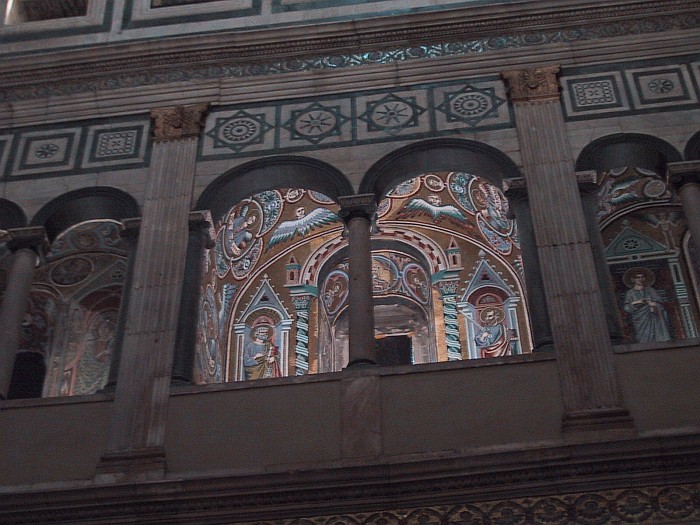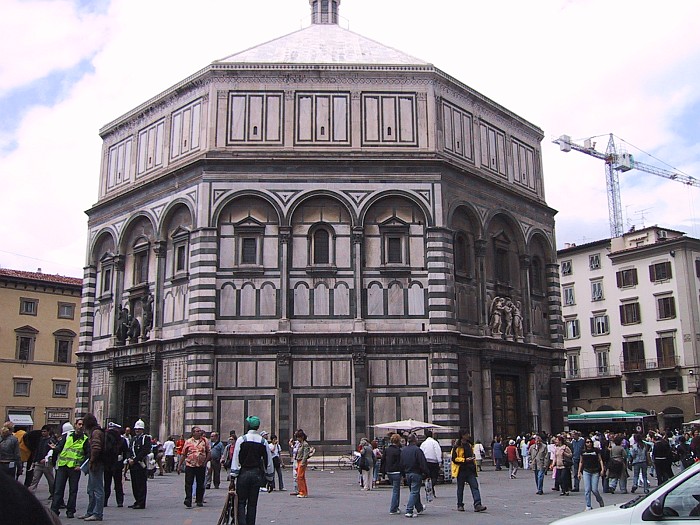

So far it has been impossible to date beginnings of the Baptistery, one of the oldest architectural monuments of the city. At one time thought to have been a pagan temple dedicated to Mars, modern research tends to date its origins to the fourth century. Its geometrical decoration in green and white Prato marble results from a happy combination of Paleo-Christian and Romanesque architecture of the eleventh to thirteenth centuries. The exterior with its three-arched facades punctuated by pedimented windows and small series of three arches corresponds exactly to the interior articulation; this is accentuated by the marble decoration. The bas reliefs and sculptures around the external doors are among the most important created in Tuscany. Their gilded bronze doors are by Andrea Pisano (present south door: 1336) and Lorenzo Ghiberti (north and east doors: 1427 and 1452). The latter is the famous Gates of Paradise, one of the greatest achievements in western sculpture, uniting late Gothic rhythmic elegance with the newly learned classical language. The original has been removed for restoration and there is a copy in its place. At present eight restored panels can be found in the Museum of the Opera del Duomo. The marble groups above the doors are Francesco Rustici's Preaching of the Baptist and Francesco Danti's Beheading of the Baptist. Inside, apart from the inlaid pavement of the turn of the twelfth and thirteenth centuries, are the wonderful large apse and vault mosaics on a gold background which were executed between 1266 and the beginning of the fourteenth century. The artists were Byzantine-trained from Venice, who worked with the more vigorous Tuscans like Meliore, Coppo di Marcovaldo and above all Cimabue, Giotto's master. Other works of sculpture here include the tomb of John XXIII, the anti-Pope who died in Florence in 1426. This was designed by Donatello and Michelozzo and the striking wooden Magdalen by Donatello from it is now in the Museo dell' Opera del Duomo.
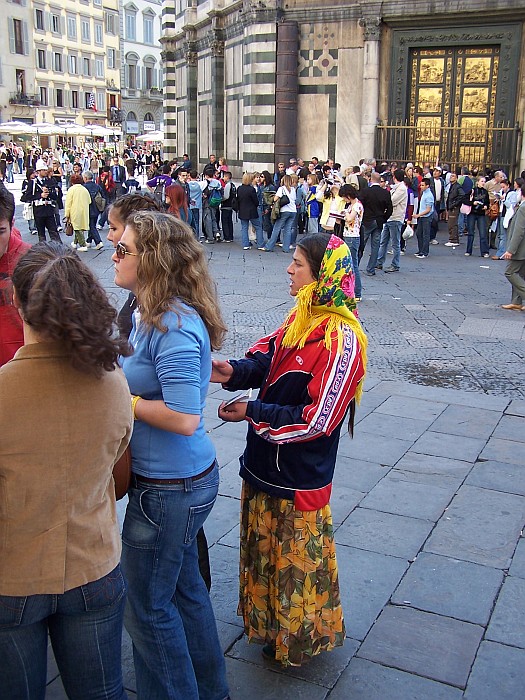
· Dante baptized here in his "beautiful San Giovanni"
· originally Florence's cathedral
· became a baptistery when the archbishop's throne was moved
to Santa Reparata
· regarded as church of the republic
· used for civil ceremonies, political meetings, investiture
of magistrates, crowning of poets, blessing of departing troops and also
the celebrations in honor of those returning
· banners of conquered enemies displayed on walls
· Romanesque structure of uncertain date (1059-1150?)
· ceiling shows colorful 13th century mosaic illustrating
Last Judgment
South Doors, Andrea Pisano (1330)
· cast from wax models with scenes from the Life of the John
the Baptist and the Three Theological and Four Cardinal Virtues
· portal surrounds by Vittorio Ghiberti (1453-61), perhaps
based on father Lorenzo's designs
· above - Decollation of the Baptist - a bronze group by
Vincenzo Danti (1500-1)
Left Door
St John’s sermons and public life
The birth of St. John the Baptist is announced to Zechariah
Zechariah is struck dumb
Visitation
Birth of St. John
Naming of St John
The youthful St John in the wilderness
St John preaches to the multitudes
St John announces the Coming of Christ
Right Hand Door (martyrdom)
St John before King Herod
St John is thrown into Prison
The disciples visit St John in prison
St John’s disciples witness Christ’s miracles
Dance of Salome
Beheading of St John
St John’s head is Shown to King Herod
Salome shows the head to Herodias
St John’s body carried to the Grave
Burial scene
Bottom Levels (Left)
Hope (winged)
Faith
Fortitude
Temperance
Bottom Levels (Right)
Charity
Humility
Justice
Prudence
Humility added to lend greater harmony to compositions. In the New Testament St John declared his insignificance before Christ.
North Doors, Lorenzo Ghiberti (1403-1424)
· illustrate the life of Christ with 4 Evangelists and 4 Church
Fathers
· above - Baptist between a Pharisee and a Levite
· commissioned in 1401 to mark Florence's deliverance from
plague
· Ghiberti wins commission over Donatello, Brunelleschi and
5 others
· Ghiberti's and Brunelleschi's trial panels are regarded
as first products of Renaissance
East Doors, Lorenzo Ghiberti (1426-52)
· called Gate of Paradise by Michelangelo
· doors on Baptistery are copies (some originals in Museo
dell'Opera del Duomo)
· carefully arranged to emphasize sacrificial act
· on either side of doors are porphyry columns from Majorca
(given to Florence by Pisa (1117) in thanks for services rendered against
marauders based in the Balearic islands
· above - Baptism of Christ - marble group by Andrea Sansovino
(1502-5); finished by Danti; angel by Spinazzi, 1792
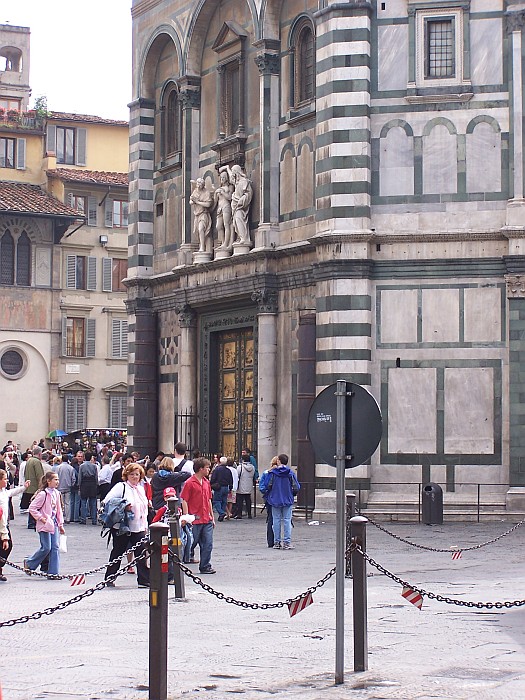
The Baptistery Doors
As early as 1330, the sculptor Andrea Pisano (c. 1290-1348) was recorded at work on the south, city-side door of the Baptistery, having been commissioned by the city of Florence to replace the old wooden door with a new one with gilded bronze reliefs. These reliefs, fourteen to each wing of the door, were framed with quatrefoils. The upper ten on each side presented scenes from the life of John the Baptist, while the remaining reliefs showed prophets.
In the winter of 1400, the Arte dei Mercanti di Calimala, the leading merchants’ guild in Florence (and responsible for the maintenance and decoration of the Baptistery), decided to have the next of the remaining two wooden doors replaced by a bronze door, and to find the best artist for the task through a public competition. Every sculptor was required to submit a trial bronze relief showing the sacrifice of Isaac within twelve months. This trial piece was to meet certain requirements in addition to the subject matter: the quatrefoil framing of Andrea Pisano's door panels was to be retained, and the sculptors were to demonstrate that they could give a precision rendering of a Biblical passage, and portray people (clothed or naked), animals, landscape and vegetation. The seven finalist sculptors chosen from the larger number who applied were offered payment for their trial pieces. . .
The decision appears to have been taken in summer 1402. The trial pieces by Brunelleschi and Ghiberti found particular favour, and are the only ones to have survived. Both had satisfied all the circumstantial requirements of size and shape, and the figures were fixed by the Bible; so the experts decided according to other criteria. The financial viability of the whole project was of course a consideration, despite the fact that a decision to go ahead had been taken in principle: Ghiberti's trial piece, weighing seven kilograms less than Brunelleschi's, was preferable in this respect, since it implied a saving of over two hundredweight of bronze for the whole door. Furthermore, Ghiberti's was cast in one piece, bar a very few extra, whereas Brunelleschi's consisted of figures mounted on a based panel, an extremely labor-intensive method. These different casting methods were not without implications for the aesthetic impact of the two works.
The trial piece
In Brunelleschi's trial piece, the victim, Isaac, is in the centre of the composition, on an altar. The altar and the rocks on which Abraham and the ram are standing mark a horizontal, though on different levels; the other figures seem merely to have been placed about these three main ones without any compelling logic. The logic of the composition derives solely from the Biblical account. An odd side effect of this is that the dramatic focus of the scene, Abraham's attempt to sacrifice Isaac and the intervention of the angel, seems an almost secondary thing.
Brunelleschi was nonetheless making a new departure. His scenic, dramatic manner of composition was largely unknown to the Gothic visual universe of the preceding age. Moreover, in Brunelleschi's relief there are echoes of classical sculpture - the nakedness of Isaac, for instance. The boy seated behind the ass is modelled on the Capitoline figure of a youth extracting a thorn. And the other youth, fetching water, is presented in a complex physical posture - his attention on the impending sacrifice - that has something of the dynamics of classical statuary. The emphasis on horizontals and verticals constitutes Brunelleschi's nod to Pisano, and remains within the Calimala's conservative brief; and yet, by placing the sacrifice at the centre of his scene, Brunelleschi does seem to have anticipated a way of seeing that was to be codified by the discovery of linear perspective only a few years later.
In contrast, Ghiberti (1378/81-1455) used a diagonal compositional grid. The rock formation that extends from the top left to the bottom right bays of the quatrefoil splits the narrative content into two separate parts, but also has the effect of linking the altar to the subsequent sacrificial victim, the ram. This in turn confirms the place of the figures in the landscape. The robes and posture of Abraham have something of Gothic tradition to them, but the naked body of Isaac, altogether in line with classical ideals, affords an arresting contrast.
The two trial pieces also differed in their rendering of the Old Testament passage in question (Genesis 22, 1-19). Unlike Ghiberti, Brunelleschi was free in his interpretation, and indeed arguably wrong. The Biblical narrative says that the attendants were left behind, some distance from the place of sacrifice, but on Brunelleschi's rocky terrace there is not even any sense that the attendants are unable to see what is happening. Some sense that the two locations were rather more separate was required by the Bible, however; the boys were expected neither to see nor to hear the sacrifice. Ghiberti solves this problem by placing his attendants behind a rock spur, which we must suppose puts them out of earshot and sight of the altar, and so satisfies the account in Genesis.
Brunelleschi is also free in his treatment of the sacrifice itself. In the Bible, the angel speaks to Abraham; Brunelleschi shows him preventing the sacrifice by seizing Abraham's arm. In Ghiberti's version, Abraham has raised the knife to strike, his eyes fixed on Isaac. This is the very moment at which the angel must free Abraham from his tormenting conflict between fear of God and love of the son he must kill; and in Ghiberti's rendering it is Isaac, looking up, who first becomes aware of the angel.
A group of thirty-four judges proved unanimous in their choice of Ghiberti's piece, by the artist's own account; and that same year the Calimala had his relief gilded. Brunelleschi's was bought by Cosimo de' Medici, who also had it gilded. Both are now in the Bargello in Florence.
On 23 November 1403, the contract for the second door of the Baptistery was agreed. The Calimala, however, had meanwhile decided that the east door of the Baptistery, facing the Cathedral of Santa Maria del Fiore should be the next to be replaced, rather than the north one. This meant changing the programme, since it was impossible, for iconographic reasons, to have Old Testament subjects on the east door of a Christian church building. The relief Ghiberti had made was thus useless for the present purposes. The Calimala made no changes in their prescriptions of form, though, continuing to abide by the overall design adopted by Pisano seventy years previously. The contract envisaged a working period of nine and a half years for the twenty-eight reliefs required; in the event, they took twenty, and it was not until 19 April 1424 that the two wings of the door were mounted in the east portal of the Baptistery.
The third Baptistery door
On 2 January 1425, less that a year after Ghiberti's first door was installed in the east portal of the Baptistery, the artists and the Calimala agreed a further contract. Ghiberti's status had fundamentally changed in the mean time. He had been involved in the architectural problems of Cathedral construction, and had thus advanced from craftsman to architect, and an expert on geometry. On 16 April 1420, together with Brunelleschi and the Cathedral's master-builder, Battista d'Agnolo, he had been appointed by the Arte della Lana (the wool and merchants’ guild) to oversee the construction of the dome of Florence Cathedral. In social terms, this placed Ghiberti on a par with scholars.
The Calimala was now dealing with a master who not only tackled the technical solution and execution of commissioned work with a degree of independence that had previously been unknown but had also assumed responsibility for the content design. Ghiberti had accomplished, for the first time, an act of emancipation from those who commissioned work, and their intentions; and this was in itself an achievement, a turning point in the social history of European art. It had implications for the third of the Baptistery doors. When the work was begun, in 1428 or 1429, the number of reliefs appears to have been reduced from twenty-eight to twenty-four; but this was not enough for Ghiberti. Partly with the bronze reliefs on the baptismal font of the Siena Baptistery in mind, he cut the number once again, to a mere ten, and came up with an entirely new framing design. He replaced Pisano's superannuated quatrefoil framing with a grid resembling a ladder, enclosed in its turn by strips of reliefs. Each relief panel was now flanked by two niche figurines, and at the sides of the rungs of ladders, there were rings containing portrait busts. This gave the reliefs a substantial, interlinked unity. The figures in the frame were distinctly larger than those in the reliefs, like small architectural sculptures reaching out from the space defined in the reliefs. Even the space that encloses the beholder is meticulously defined by the door frame, the frame around a real architectural space. This addition of different spatial levels is matched by the spatial depths within each relief. Every one of the reliefs has its own independent artistic value within the overall scheme, to an extent hitherto unknown.
It is the distinctive working of the reliefs that makes this possible. In Pisano's Gothic panels, and indeed in Ghiberti's first door, all the figures had to be of equal size, with no perspective differentiation; the priority was to fill the area available, rather than to suggest spatial depth. But Ghiberti aimed to show closer figures as appearing larger, and figures further off as appearing smaller, as figures do in the real world; and so he adopted the new perspective approach in the third door, which made possible the transformation of a flat surface into the semblance of three-dimensional space.
Ghiberti's interest in the spatial dimensions made available by perspective went hand in hand with an interest in truth of content. It was now possible to present different phases of a narrative on different spatial levels, and to relate them internally according to the contextual requirements of the story. Thus the ten reliefs of the Gates of Paradise, in presenting their Old Testament subjects, include a varying number of scenes within each relief.
The Calimala was delighted with Ghibertis new door, to say the least; and the artist himself said later that it was the finest of all his works. Indeed, the guild was so impressed that they decided on an unprecedented move. Because Ghiberti's door was so superlatively beautiful, they decided to install it not in the place it was intended for (and to which the iconographic programme was apt) but in place of the east door. This meant removing the present east door, with its Life of Christ, Church Fathers and other Christian material, to the north portal, and hanging the new door in the east in its stead. This was a radical departure, in so far as Christ was having to quit the preferred east side of the Baptistery, to make way for an Old Testament cycle; this flew in the face of traditional priorities. But Lorenzo Ghiberti's magisterial artistry had persuaded the guild to abandon their preconceptions. It was the first time that a work of art was placed in its position for aesthetic reasons rather than on grounds of content. Toman, editor, The Art of the Italian Renaissance (176-180)
The Gates of Paradise
Ghiberti, Commentarii
(in Elizabeth Holt, A Documentary History of Art)
I was commissioned to do the other door, that is, the third door, of S. Giovanni. The commission gave me permission to execute it in whatever way I believed would result in the greatest perfection, the most ornamentation, and the greatest richness. I began the work in frames one and a third braccia in size. The stories, which had numerous figures in them, were from the Old Testament. With every proportion observed in them, I strove to imitate nature as closely as I could, and with all the perspective I could produce [to have] excellent compositions rich with many figures. In some scenes I placed about a hundred figures, in some less, and in some, more. I executed that work with the greatest diligence and the greatest love. There were ten stories all [sunk] in frames because the eye from a distance measures and interprets the scenes in such a way that they appear round [plastic]. The scenes are in the lowest relief and the figures are seen in the planes; those that are near appear large, those in the distance small, as they do in reality. I executed this entire work with these principles.
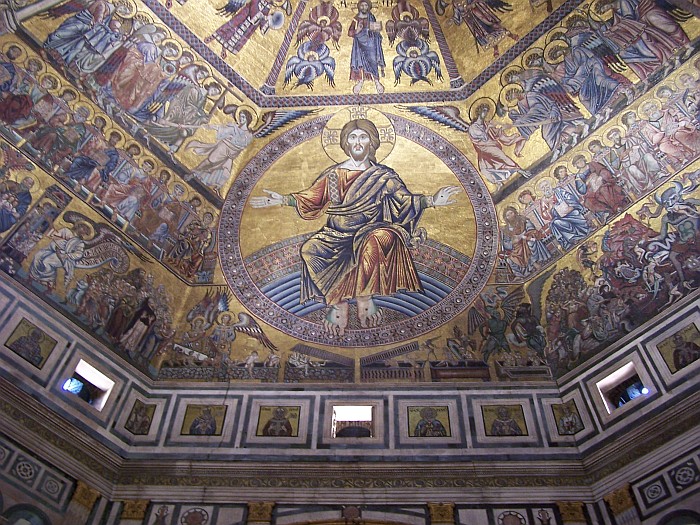
Lorenzo’s second set of doors was declared officially completed and gilded during the summer of 1452. On July 13, the Calimala decided to have the new doors set up in the eastern portal of San Giovanni, the place of honor facing the cathedral, “because of [their] beauty,” while Lorenzo’s first doors would be moved to the northern portal, where they still can be seen today. The exact date when the doors were hung is unknown, but it was probably that summer. The total cost of the doors was figured at 14,494 florins, 3 lire, and 4 soldi – slightly less than the reckoning for the first doors. Lorenzo and his son Vittorio accepted the house and workshop where the doors were created in lieu of a final payment of 250 florins, yet another indication of Lorenzo’s increasing appetite for real estate, not to mention the relatively low cost of real estate in Florence at this time. Lorenzo obtained the property, later described as having “gardens, courtyards and porticoes, with a well, a hall and bedrooms,” for the equivalent of fifteen months’ salary. The location of this house and workshop is still marked today, on what is now Via Bufalini, just across from the hospital of Santa Maria Nuovo.
As he had with his first doors, Lorenzo signed his name boldly, although this time he used the new name that proclaimed his newfound legitimacy: LAVRENTII CIONIS DE GHIBERTIS . . . MIRA ARTE FABRICATVM, “Lorenzo Cione de Ghiberti . . . has made this with wondrous art.” Fittingly, his name runs directly below his finest single creation, the exquisite Jacob and Esau panel, but despite the erudition demonstrated in the Commentaries, Lorenzo apparently had some trouble with humanist script – he carved the N’s in LAURENTII and CIONIS backward and had to correct the spelling of FABRICATVM. Ghiberti’s insightful self-portrait gazes out from the doorframe, just to the right of his name, while a portrait of his son Vittorio, looking a bit like a younger Lorenzo, gazes out from the frame beside him. When these doors were first commissioned in early 1425, Vittorio had been six years old. By the time they were finished, he was in his mid-thirties, an active partner in the project and the workshop, sharing with place of honor with his aging father. Walker, The Feud that Sparked the Renaissance (216-7)
PANEL 1 – Adam and Eve
There are ten scenes. The first is the creation of man and woman and how they disobeyed the Creator of all things. Also in the same scene is shown how they were driven from paradise for the sin they committed; thus in that panel four stories – that is scenes – are given.
· Creation of Adam
· Creation of Eve
· Temptation
· Expulsion
The ten large panels of Lorenzo’s second doors are one of the great artistic achievements of the Renaissance, and it is on these panels that his reputation rests to the present day. Each panel contains a number of scenes from the given biblical story, with the largest number of scenes in the earlier panels. For example, the Genesis panel, which was designed first and still shows the lone, languid figures of the International Style, includes five separate scenes: the Creation of Adam, the Creation of Eve, and the Expulsion from Paradise, all modeled in near-full relief in the foreground, with the Temptation in the Garden and the Creation of the Universe modeled in flat relief in the background. In order to balance so many scenes in a single composition, Lorenzo had to sacrifice the narrative impact of certain scenes from the overall pictorial effect. In this early panel, the composition is balanced almost too perfectly across the width of the panel, to the point where the overall effect is static though the individual scenes have an elegant beauty. Walker, The Feud that Sparked the Renaissance.
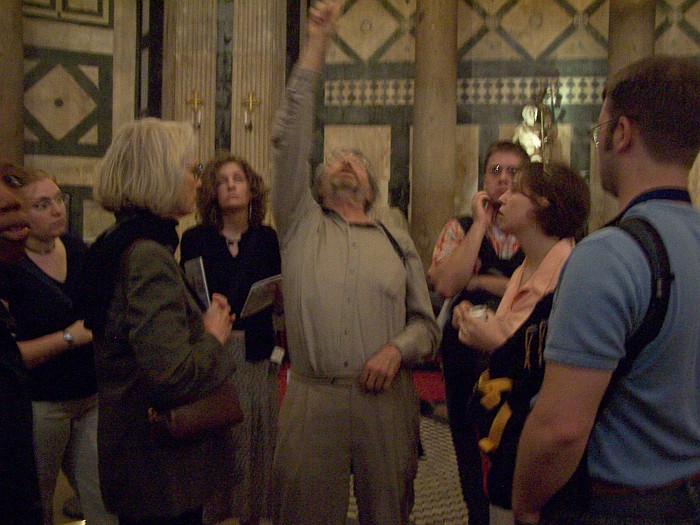
As he continued to work, Lorenzo experimented with diagonal designs that created a more dynamic composition, while drawing the viewer into the scene. The next three panels, Cain and Abel, Noah, and Abraham, all reflect this approach, with the rising, roughly triangular mountains of the Cain and Abel and Abraham panels creating a natural setting for the separate scenes, while in the Noah panel the ark is portrayed as a pyramid – an unusual iconography that reflects Lorenzo’s contact with Ambrogio Traversari, who got the idea from an early Greek Christian theologian named Origen. Walker, The Feud that Sparked the Renaissance.
PANEL 2 – Cain and Abel
In the second panel, Adam and Eve beget Cain and Abel, who appear as small children. Then there is [shown] how Cain and Abel offered [their] sacrifices. Cain sacrificed the worst and vilest thing he had. Abel sacrificed the best and noblest. Abel’s sacrifice was very acceptable to God, and that of Cain was entirely the opposite. There was [shown] how Cain slew Abel in envy. In that scene Abel was watching the animals and Cain was tilling the soil. Also there was [shown] how God appeared to Cain and demanded of him the brother he had slain. Thus in each panel are scenes of four stories.
· Adam and Eve with Cain and Abel
· Cain and Abel offer first fruits
· Abel watches sheep while Cain ploughs the earth
· Cain kills Abel
· God questions Cain
PANEL 3 - Noah
In the third panel is [shown] how Noah came out of the ark with his sons, his daughters-in-law, his wife, and all the birds and animals, and how with all his company he offered sacrifice. There is [shown] how Noah planted the vine and became drunk and Ham, his son, mocked him; and how his other two sons covered him.
PANEL 4 – Abraham and Isaac
In the fourth panel is [shown] how three angels appear to Abraham and how he worshipped one of them; and how the servants and the ass remain at the foot of the mountain and how he stripped Isaac and wanted to sacrifice him, and the angel seized the hand with the knife and showed Abraham the ram.
· jagged rocks symbolize Abraham's pain
· carefully arranged to emphasize sacrificial act
. . . in the scene of Abraham sacrificing Isaac, where Lorenzo returned to the subject that won him the commission for his earlier set of doors, he portrays the angel grasping Abraham by the wrist, just as Filippo had done in his original panel for the competition. The rest of the design is all Lorenzo, however with graceful, yet realistic figures, a cascading mountainside, and a forest of delicate trees. Even the moment of physical contact between the angel and Abraham becomes a graceful curve rather than the jarring, arrested movement that Filippo had imagined. Walker, The Feud the Sparked the Renaissance
PANEL 5 – Esau and Jacob
In the fifth frame is [shown] how Esau and Jacob were born to Isaac; how Esau was sent to hunt; how the mother instructed Jacob, gave him the kid, and fastened the skin at his neck, and told him to ask the blessing of Isaac; and how Isaac searched for his neck, found it hairy, and gave him his benediction.
· birth of Esau and Jacob
· Isaac salutes his son Esau setting out for the hunt
· Rebecca and Jacob prepare to deceive Isaac with the skins
of kids
· Isaac blesses Jacob
Esau passes on his birthright to Jacob, in the same manner as the Gentile will one day replace the Hebrews as the Chosen People.
In his Commentaries, Lorenzo wrote of the panels, “I strove to observe with all the scale and proportion, and to endeavor to imitate Nature in them as much as I might be capable; and with all the principles which I could lay bare in it and with excellent compositions and rich with very many figures.” The word translated as “principles” is lineamente, from the old Latin term lineamenta. During the Middle Ages, this word was used to denote lineage or ancestry, but Lorenzo used it in much the same way that his friend Leon Battista Alberti used it in De Pictura, something close to its original meaning as “lines” or a “line drawing.” What Lorenzo is getting at here, with scale, proportion and lineamenti, are the principles of linear perspective, but though he claimed to follow those principles in all the panels, he constructed a coherent perspective system in only three: Jacob and Esau, Joseph, and Solomon. These panels followed the Abraham, and they clearly reflect Ghiberti’s close association with Alberti during the mid-1430s.
All three of these panels use sophisticated architectural settings to establish the perspective scheme, and in these settings Lorenzo shows himself to be a gifted architectural designer in an aesthetic sense, even if he did not have the structural knowledge to construct such buildings in the real world. The figures inhabit these architectural settings with a wonderful reality and dimensionality that give each separate scene a dynamic life far beyond the static composition of Genesis, Jacob and Esau is the masterwork of the trio, and many consider it the masterwork of Lorenzo’s career: powerful, personal, and close to perfection. In this panel, more than any other by Lorenzo, perhaps even more than any relief by Donatello, the architectural setting and perspective scheme create a dynamism between foreground and background, between left and right, and up and down. Brunelleschi’s buildings are sometimes described as diaphragms, meaning they define and separate space into interior and exterior in a fluid and dynamic manner. In Jacob and Esau, Lorenzo’s imagined architectural setting – an open Roman-style hall with sets of wide, rounded arches and tall pilasters receding into the distance – serves a similar purpose, drawing the viewer inward, separating some scenes while connecting others.
A group of four women stand in the foreground at the bottom left. They have come to visit Rebecca in childbirth, but Rebecca herself lies within the hall, a proportionately small figure in low relief, while the women are fully and beautifully modeled. Lorenzo was always at the forefront in his representations of women, but these women are his most beautiful and realistic expressions of the female form. Unlike the slender swaying figures of his earlier work, they stand solidly on the earth with the curves of their bodies – almost voluptuous by the standards of the time – and it seems likely that Lorenzo modeled them from life. Near the center of the panel, on the steps of the hall, a balding, bearded Isaac gestures toward Esau, sending him on the hunt for venison. Esau stands with slender, boyish grace, his back to the viewer, his hunting dogs behind him. To the right, sitting on a marble bench, Isaac blesses a kneeling Jacob with Rebecca watching anxiously. Other scenes are played out in the background at succeeding levels of depth: Esau and Jacob quarreling, Rebecca advising Jacob, Rebecca praying to God on the rooftop, Esau hunting in the distant mountains. The composition is a wonder of dimensionality, dynamic balance, and narrative power.
Complementing its artistic brilliance, the Jacob and Esau panel has a personal poignancy that is often lacking in Lorenzo’s art. This is especially evident in the father-son scenes, and though critics have little remarked on it, there were parallels between Lorenzo's own family life and the family life of the biblical story. Like Isaac and Rebecca, Lorenzo and his wife, Marsilia, had two sons – not twins, but very close in age. If we assume the panel was modeled around 1435, Tomasso would have been eighteen and Vittorio would have been seventeen, about the ages of Esau and Isaac as portrayed in the relief. Both of Lorenzo's sons became goldsmiths, but just as Isaac supplanted the firstborn Esau and received the blessing of his father, the younger Vittorio jointed his father’s business and ultimately took over his workshop. We know little of Tomasso; he was active in the workshop around 1445, but even then he had a separate partnership with another man, and he apparently went his own way at various times. Perhaps there was a rift with his father, or perhaps Tomasso was just more independent-minded than his younger brother. Certainly the man who created these figures with such subtle poignancy understood what it was to be a father and to feel frustration with a beloved son who did not quite meet his expectations. At the same time, we know that Lorenzo and Vittorio worked together as partners for many years, and there is something equally powerful and poignant in the blessing of the younger Jacob. Walker, The Feud that Sparked the Renaissance
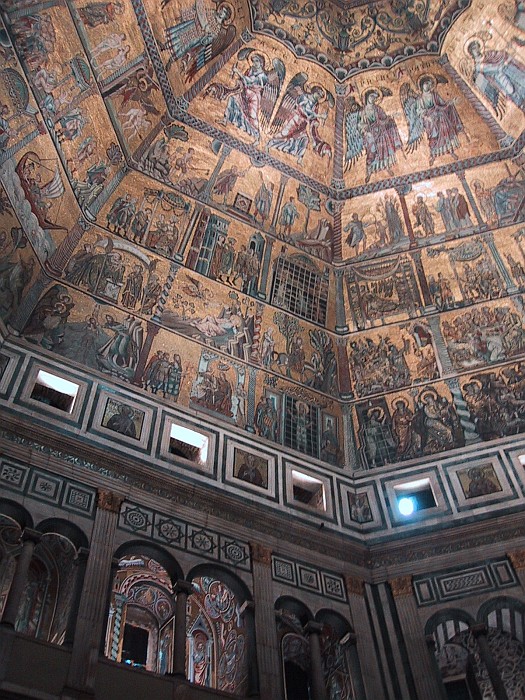
Lorenzo’s other perspective panels, Joseph and Solomon (which was apparently created out of its biblical order), do not quite reach the perfection of Jacob and Esau, and it seems that the artist was already moving in a new direction that reached fruition in the final group of reliefs: Moses, Joshua, and David. All of these later panels feature large crowd scenes, not quite the “hundred figures” of which he later boasted, but an impressive array of well-articulated individuals that create something like a human architecture. Walker, The Feud that Sparked the Renaissance
PANEL 6 – Joseph and His Brothers
In the sixth panel is [shown] how Joseph is placed in the cistern by his brothers; how they sold him and how he is given to Pharaoh, the king of Egypt, and it was revealed through a dream that there would be a great famine in Egypt, and the remedy Joseph gave, and all the country and provinces were spared, for their needs were met; and how he was greatly honored by Pharaoh. [Also is depicted] how Jacob sent his sons, and Joseph recognized them; and how he told them to return with Benjamin, their brother, otherwise they would receive no grain. They returned with Benjamin and Joseph gave them a feast and had a cup placed in Benjamin’s sack. [There is shown] how the cup was found and Benjamin was led before Joseph and how he made himself known to his brothers.
· Joseph is cast by his brethren into the well
· Joseph is sold to the merchants
· The merchants consign him to Pharaoh
· Joseph interprets Pharaoh’s dream
· Pharaoh pays him honour
· Joseph sends his sons to Egypt for corn
· Joseph recognises his brothers and returns to his father’s
house
Joseph, who is betrayed and sold by his brothers but later forgives them, is the image of Christ’s sacrifice and His mercy.
Ghiberti really seems to improve from panel to panel, especially (says Vasari) “where there were houses”. In the panel of the Stories of Joseph, “for all the effects and varieties of things . . . among all the works the most worthy and most difficult and the most beautiful”), Lorenzo “made a round temple shown in perspective with great difficulty, inside which are figures in various attitudes loading corn and flour; and extraordinary donkeys”. Opera
PANEL 7 - Moses
In the seventh panel is [shown] how Moses received the tables on the mountain top, and how Joshua remained half way up the mountain, and how the people wondered at the earthquake, lightning and thunder, and how the people at the foot of the mountain were amazed.
PANEL 8 - Joshua
In the eighth panel is [shown] how Joshua went to Jericho, came and crossed the Jordan, and placed [there] twelve tents; how he went around Jericho sounding the trumpets, and how at the end of seven days the walls fell and Jericho was taken.
“very beautiful are some [figures] in low relief, when the ark is carried around the walls of the city . . with the sound of the trumpet the walls fall and the Hebrews capture Jericho, in which the landscape is diminished, and lowered with observation of the first figures to the mountains, and from the mountains to the city, and finally from the city to the far distance in very low relief.” Opera
PANEL 9 – David and Goliath
In the ninth panel is [shown] how David slew Goliath and how the people of God destroyed the Philistines, and how David returned with the head of Goliath in his hand and how the people came to meet him making music and singing and saying, “Saul destroyed one thousand, David ten thousand.”
We see David cutting off the head of Goliath “with a boyish and a proud attitude” (Vasari); the army of the Philistines is defeated, and David returns with the giant’s severed head to his people, who welcome him rapturously. Opera
The David is the finest of these [Joseph, Solomon), with a swirling, dynamic battle scene in the foreground that captures motion in bronze, and a finely etched cityscape of Jerusalem in the background. These panels do not really suffer for a lack of a well-defined perspective scheme; in a sense they are a movement beyond single-point perspective, presaging the multipoint perspectives of Paolo Uccello, Piero della Francesca, and Leonardo da Vinci. Lorenzo doesn’t have the mathematical grounding to carry it off, but that is what he is searching for and unlike the later artists, who worked with painting on plaster, wood, and canvas, Lorenzo worked his swirling, mulitpointed visions in wax and cast those visions in bronze. Walter, The Feud that Sparked the Renaissance
PANEL 10 - The Meeting between Solomon and the Queen of Sheba
The Meeting between Solomon and the Queen of Sheba, where there is a “house drawn in perspective, very beautiful”, has often been seen as a direct reference to the Council of Florence (originally convoked at Ferrara, and moved to Florence by Pope Eugenius IV in 1439 at the request of Cosimo the Elder), whose purpose was to reunite the Latin and Greek Churches. In the door, writes Vasari, “one realises what the skill and genius of a sculptor can do when he is casting figures in the round, in half relief, in low relief, or in very low relief. In the composition, the striking poses of his male and female figures, in the variety of the architectural perspectives, and the consistently graceful bearing of both sexes, he demonstrated his grasp of decorum, expressing gravity in the old, and lightness and grace in the young”. Opera
The last panel, depicting the meeting of Solomon and the Queen of Sheba, can be interpreted as the mystical wedding between Christ and the Church, as well as a direct reference to the reconciliation between the Eastern and Western Churches, ripped apart by the Schism of 1054. Baptistery
There are twenty-four figures in the frieze that surrounds the stories. Between one frieze and the other is placed a head. There are twenty-four heads. Executed with the greatest study and perseverance, of all my work it is the most remarkable I have done and it was finished with skill, correct proportions, and understanding. In the outer frieze on the doorjambs and the lintel is a decoration of leaves, birds, and little animals as is suitable to such ornamentation. There is also an architrave of bronze. On the inside of the doorjambs is a decoration in low relief made with the greatest skill. And likewise the threshold, at the base, that decoration is of fine bronze.
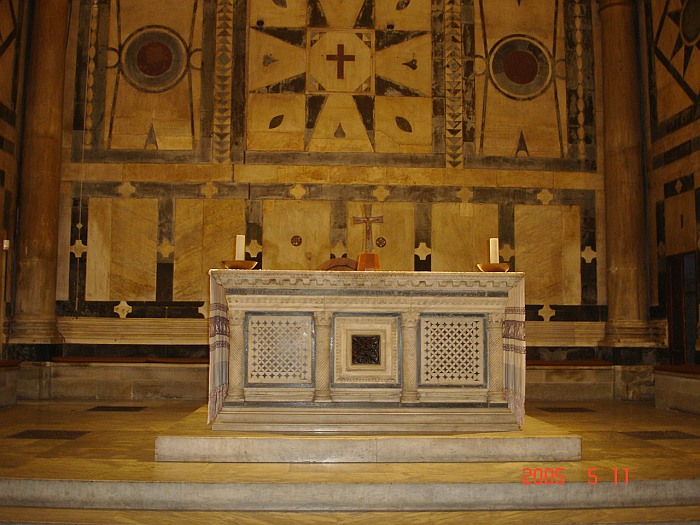
Altar
Nicola Pisano, Pulpit
When Nicola Pisano (c. 1220-1278/84) completed his pulpit in the Baptistery at Pisa in 1260, he was ahead of his time, in so far as he had created sculptural forms that would only become staple principles of the Renaissance decades later. In the amiable war between architecture and sculpture, Pisano's Baptistery pulpit struck a blow for the autonomy of sculpture. Thus the personification of fortitude as Hercules, in particular, was not merely the first heroic nude anywhere in the centuries since antiquity; it also featured elements of figural molding that separated the figure from the stiffer architectural background and gave it a presence accountable wholly in terms of the organic movement of the body. The verisimilitude of this naked human body, complete with the skeletal frame, muscles and sinews, was as indebted to classical originals, however, as it was to any study of the acute weighting and interplay of a leg tensed for standing and a leg relaxed, at ease. For the first time, the classical principles that had governed figure composition in antiquity were being applied to post-classical sculpture. Nicola's immediate observation of organic fact was not as important for his work on the sculpture as the study of antique models which he saw on sarcophagi in Pisa.
Whatever the case, this earliest Renaissance sculpture remained an isolated achievement. It was not until around 1400 that significant sculptural work had an occasion to rise to: the famous competition to make the second bronze doors of the Baptistery in Florence.
